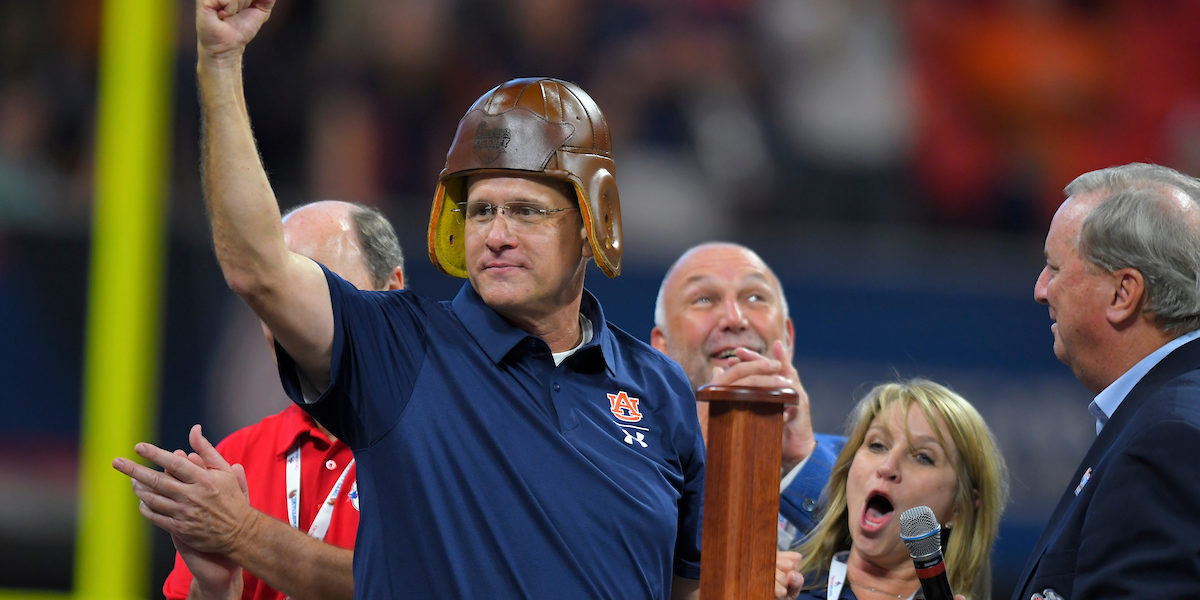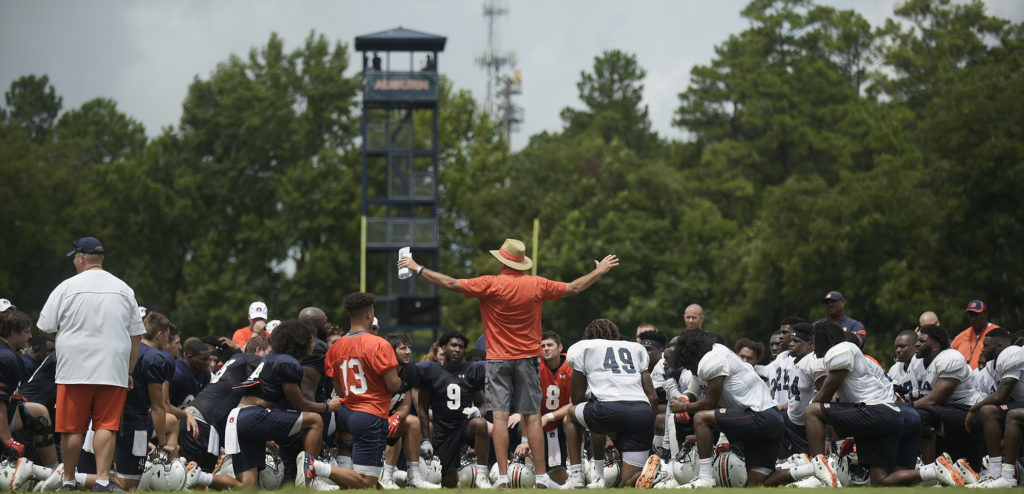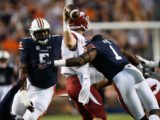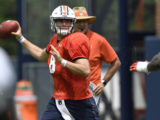
How does Auburn fix its offense?
September 28, 2018
Auburn coach Gus Malzahn talks to his No. 10 Auburn Tigers who square off against Southern Miss on Saturday Todd Van Emst/AU Athletics
I have been one of the most vocal defenders of Gus Malzahn, but even I was empathetic of his critics after watching Auburn’s offense total just 225 yards versus this year’s SEC doormat Arkansas.
Malzahn has been on an Auburn sideline for nine seasons – three as an offensive coordinator and this year is his sixth as head coach; never has he had a team produce such a low number of offensive yards in a win.
I admit, I’ve been critical of the Auburn offensive play-calling and the offense as a whole — from the big uglies up front to the quarterback and his receivers who seem to have a couple drops every game. It’s not championship ball, but fortunately for the Auburn offense there’s a lot of season left to improve.
And like I’ve previously said, it’s not play-calling alone, nor the Auburn offensive line, or the wide receivers and running backs for that matter, who are singularly to blame for the woeful Tiger offense. No, it’s a combination of all needing to rise up, get on the same page and become more polished.
The play-calling needs to improve, yes, but the execution by the players needs to equally get better.
This week I talked at length with someone who is as plugged in to the Auburn football program as anyone and he was able to sway my opinion somewhat on the pitiful offensive performance versus Arkansas.
Sources close to the situation reassured me that the mindset of the Tigers going into the Arkansas game against a weak opponent was that Auburn would work on the part of its offense that needed most improvement — the interior run game.
Auburn’s offensive game plan was essentially to impose their will on Arkansas by running up the middle and being vanilla as possible. Problem is, it didn’t work. And instead of scrapping the game plan, the Tigers stuck to it and beat an SEC opponent by 31 points. In spite of its offense.
Sometimes wins are ugly and Auburn’s 34-3 victory over Arkansas, at least from an offensive perspective, was like seeing your grandfather naked; you wanna gouge out your eyeballs afterwards.
In every fanbase, there’s the sunshine pumpers and then you have the doom and gloomers, so the Auburn Family is no different. But there’s not much of an in between. Hopefully I can become the middle ground because I do hear and agree with both sides.
From the perspective of the sunshine pumpers, I’m reminded that Auburn’s still a Top 10 team who just defeated an SEC West opponent by 31 points and covered the 30-point spread.
The doom and gloomers remind me that it was against one of the worst power-five teams in college football, where Auburn’s offense had its lowest yardage (225) output in a win since 2006.
As indicated by Auburn’s playmaking wide receiver Ryan Davis after the Arkansas game, the Tiger offense is obviously not in sync.
I guess that’s where my frustration lies — instead of having a vanilla offensive game plan against the Razorbacks, one would have thought that after a one-point loss to LSU, the offense would have wanted to flex its muscle and especially work on the timing of its quarterback and wide receivers, along with improving the cohesiveness of its offensive line.
But neither happened versus Arkansas.
If anything, the offense took a step backwards according to the numbers. But in fairness, the numbers are slightly skewed when you consider that the Auburn defense and special teams provided four opportunities where the Auburn offense inherited the ball deep inside Arkansas territory. Not to mention, Auburn got a 96-yard kick off return for a touchdown by Noah Igbinoghene and the Tiger special teams. And don’t forget about the amazing pick six from starting nickel back Javaris Davis that was unfortunately called back because of a penalty right before halftime.
So I’m told not to take anything away from the Arkansas game and maybe we should chalk it up to an Auburn offensive anomaly. In other words, the Tigers didn’t even need its offense to help beat the brakes off of Arkansas.
However, Malzahn’s squad could have used the Arkansas game to define its offensive identity rather than trying to force a square peg in a round hole in just game four of the season. Even if you can rely on your defense and special teams to easily win the game, you certainly don’t wanna have the perception that your offense rolled over and played dead, but here we are steadily checking for a pulse.
And just for the record, if Auburn has a big offensive performance when they host Southern Mississippi this upcoming Saturday at 3 P.M. CST on the SEC Network, I’ll still have my reservations.
How does Auburn fix its offense?
Ever since Malzahn was named Auburn’s head coach prior to the 2013 season, the Tigers have more total rushing yards in the SEC than any other team.
That would tell you that Auburn’s offensive identity under Malzahn has been built by a run-heavy scheme. For the most part, Auburn has featured an excellent run game and run blocking offensive line during Malzahn’s tenure on The Plains both as an offensive coordinator and as a head coach.
In fact, did you know that Auburn passed the ball more in Malzahn’s very first season as offensive coordinator in 2009 than at any other point during his Tiger tenure?
It’s true, the Tigers slung it around on 40% of their offensive plays in 2009 while quarterback Chris Todd led Auburn’s first Malzahn coached offense. Now 40% of plays doesn’t necessarily sound like a high number of passes, but under Malzahn it most certainly is, even when he’s had a pro-style quarterback to run his scheme like a Chris Todd, or a Jarrett Stidham for that matter.
And can I just take a timeout here? I hope you don’t mind. When I decide to write a story like this, an expose if you will, I like to submerge myself into the spiel by digging deep and doing research, watching film, et cetera. Sometimes stuff is revealed at a later point in the story that changes the author’s perspective and the way he writes it, so if you ever notice a shift in my attitude in the middle of a column, now you know why.
As I dove into this saga, I started seeing both sides of the equation. I was previously a tried and true sunshine pumper, but the film and numbers have conceived cynicism.
I went back and watched Chip Lindsey’s Southern Miss offenses in 2014 and ‘15. I then watched film of his 2016 offense when he was the offensive coordinator at Arizona State before Malzahn hired him away prior to the 2017 season.
I noticed one central theme with the offenses that Lindsey had full control over before his arrival at Auburn — they were all very balanced. As in 50% run and 50% pass. Lindsey averaged a perfect 50/50, run-pass ratio in his three FBS seasons as an offensive coordinator before arriving on The Plains.
I then compared that to Auburn’s run / pass ratio in the seven seasons under Malzahn before Lindsey got there. In those years, Auburn averaged running the ball a whopping 67% of the time while only passing on 33% of plays.
You don’t even wanna know what Lindsey’s run / pass ratio is at Auburn. I can give you a hint and tell you that it resembles less of what a true Lindsey offense produces and mimics more of what a Gus Malzahn offense manufactures.
Chip Lindsey’s run / pass ratio at Auburn is 64-percent run and 36-percent pass.
Maddening to be honest with you.
Malzahn said that when Lindsey was hired to be his offensive coordinator prior to the 2017 season, it was with the intentions of bringing more balance to the Tiger offense.
If you’re going to hire a man to do a job, you should give him the proper respect by allowing the man to do his job. I compare the numbers and I’m not convinced that Lindsey has the freedom to run this offense as he sees fit. How could you come to any other conclusion?
Based upon people in the know, I’m convinced Lindsey does in fact call the offensive plays.
But does he call the plays that are dictated to him or does he call the Auburn offense the way he wants to call the Auburn offense?
You’ve got a more than capable quarterback and wide receivers the last couple seasons and you’re only passing the ball 36-percent of the time? Instead, last year you ride your star running back into the ground and then look clueless without him.
I’m not pinning this crap on Chip Lindsey, I can promise you that. In fact, I don’t even have to point the finger at anyone because people can see it for themselves.
64-percent run is predictable and quite frankly doesn’t suit Auburn’s current offensive personnel. Lindsey has proven at Arizona State and Southern Miss that he can have an offense that’s balanced and efficient, so let the man do his job.
You’d be foolish to believe that after Malzahn has been in the SEC for nine seasons, defenses haven’t learned his tendencies. However, there’s a way to combat that if you’re Malzahn, but it takes humbling yourself, tossing aside your foolish pride and delegating full control of the Auburn offense to Chip Lindsey.
Even going back to last season, I believe if Lindsey had the freedom to run his offense like he wanted, Auburn’s run / pass ratio would be a lot closer to that 50-50 mark rather than 64-36.
Percentage of plays Auburn either runs or pass under Gus Malzahn
2009: 60% run – 40% pass
2010: 69% run – 31% pass
2011: 65% run – 35% pass
2013: 72% run – 28% pass
2014: 65% run – 35% pass
2015: 66% run – 34% pass
2016: 69% run – 31% pass
2017: 63% run – 37% pass (Chip Lindsey o.c.)
2018: 64% run – 36% pass (Chip Lindsey o.c.)
Chip Lindsey’s run – pass ratio prior to Auburn
2014: 44% run – 56% pass (Southern Miss)
2015: 49% run – 51% pass (Southern Miss)
2016: 53% run – 47% pass (Arizona State)
I like Gus Malzahn. In fact, I like ‘em a lot. I think he’s a fine coach. I think a perfect comparison would be Auburn legend Shug Jordan in not only performance but character. Their winning percentages are practically the same — Jordan has a .674 winning percentage while Malzahn is a tad higher at a mark of .678, but Malzahn has consistently played one of the toughest schedules in college football.
What if I told you that Auburn, under Gus Malzahn, has had one of (if not THE) toughest schedules in the country? I compared Auburn’s schedule to that of every FBS school. Here are the results: pic.twitter.com/Gei8mDbbnc
— joshdub (@joshdub_) September 26, 2018
And remember, he’s the head coach so he has every right to do whatever the hell he wants to do with his football team. But if he can take a note from the best coach in college football history, Malzahn’s neighor up the interstate in Tuscaloosa by the name of Nick Saban, Gus would be willing to change with the times and evolve.
In fact, I remember when everyone, myself included, mocked Saban for hiring Lane Kiffin, but Saban got out of his way for the most part and allowed Kiffin to implement a legitimate downfield passing attack that truly stretched the field and kept the opposing defenses on their heels. Defenses weren’t selling out to stop Alabama’s run every play because they’d get beat by the forward pass.
A run-heavy offensive scheme with a true dual-threat quarterback like a Cam Newton or Nick Marshall makes total sense, but why would you choose to be as predictable in your play selection of being run-heavy when you have a prototypical quarterback like Jarrett Stidham?
In this series vs. LSU, Auburn used its strength by advancing the ball down the field with beautiful throws by Stidham to Slayton and Schwartz, who each had equally impressive catches. Deep in LSU territory, AU then ran the ball four straight times before being stuffed on 4th & 1 pic.twitter.com/1AETRof9Ja
— Skye Underwood (@SkyeUnderwood) September 28, 2018
I know everyone wants to point fingers at an offensive line that had to replace four starters, but there’s ways to protect a young o-line as Cole Cubelic pointed out in the preseason – “quick strikes on the perimeter – tunnel screens, swing passes & screens to the runningbacks, quick slants – plays to get the ball outta the quarterback’s hands early.”
Malzahn’s offenses at Auburn have always been run-heavy and have always used the run to set up the pass, but if Auburn truly wants to fix its offense with its current personnel, Malzahn would allow Lindsey to do what he hired him to do – bring more balance to the Auburn offense by actually giving him the freedom to do so.


